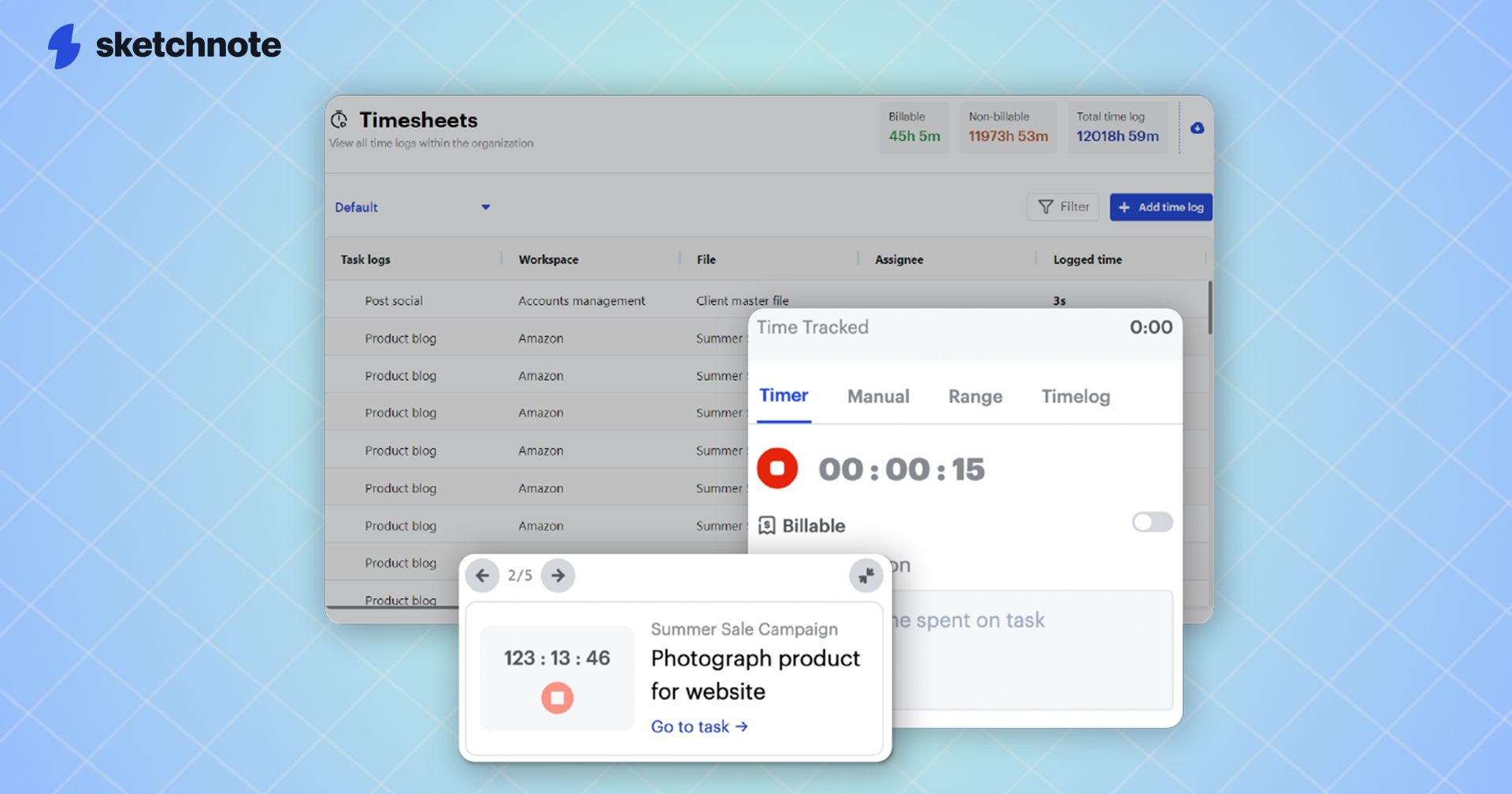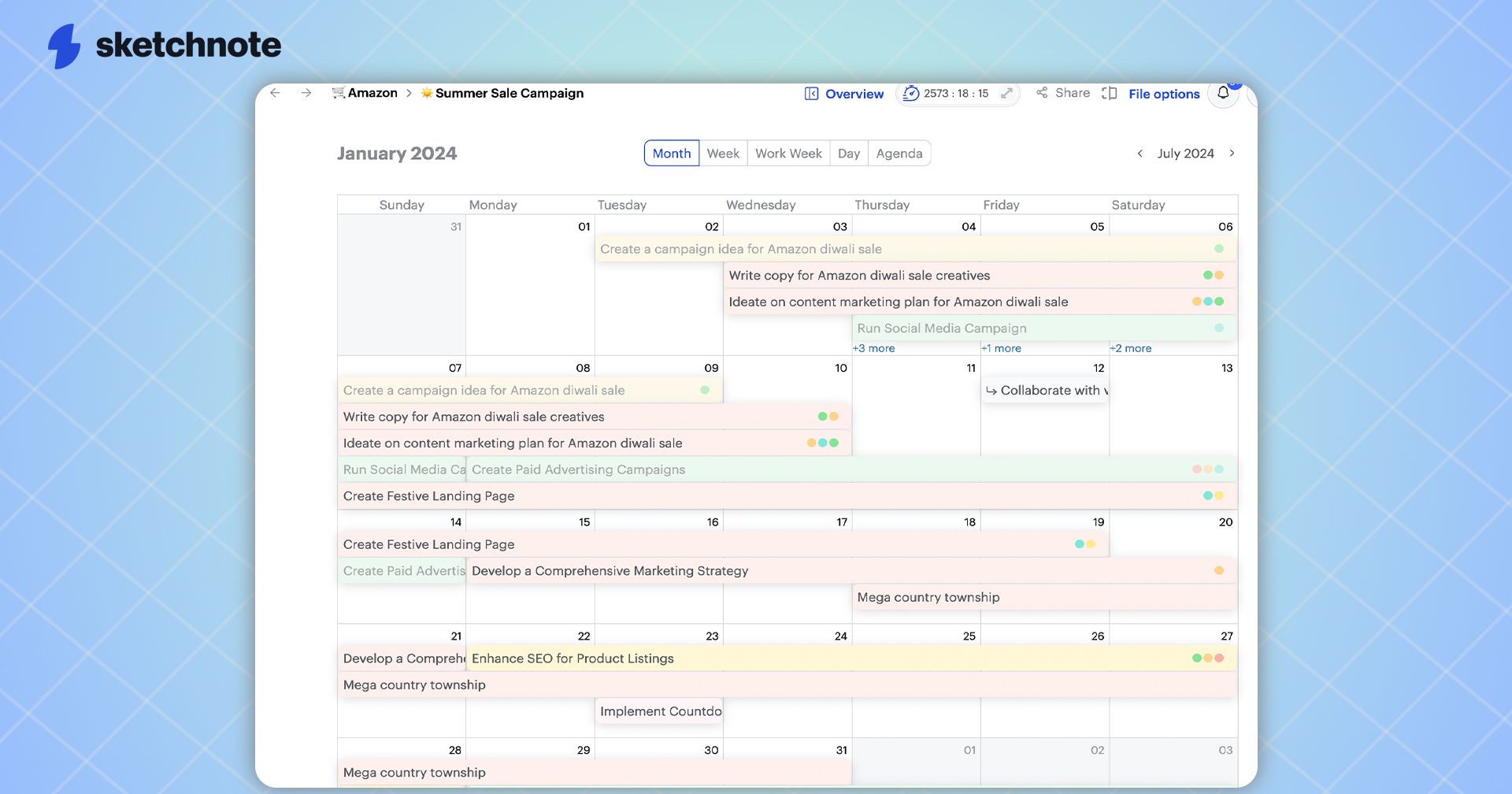Efficiency is the cornerstone of success in ad and marketing agencies. As a professional in this fast-paced environment, mastering time management is necessary to boost your productivity and achieve your goals.
In this article, you’ll discover the top 10 actionable tips to streamline your workflow, enhance collaboration, and make the most of your time. With integrated tools like Sketchnote’s start and stop timers, manual time entry, automated time tracking, and comprehensive timesheet views, you’ll find it easier than ever to track and optimize your productivity. Let’s dive in!
Prioritize Tasks with To-Do Lists
A well-crafted to-do list is your best ally when it comes to managing time effectively in agencies. By prioritizing your tasks, you can focus on what truly matters—enhancing your productivity and ensuring deadlines are met with ease.
Start by making tasks out of every job you need to accomplish, big or small. This helps clear your mind and provides a comprehensive overview of what lies ahead. Next, categorize these tasks by urgency and importance. A commonly used method is the Eisenhower Matrix, which divides tasks into four quadrants:
- Urgent and Important: Do these tasks first.
- Important but Not Urgent: Schedule these for later.
- Urgent but Not Important: Delegate these if possible.
- Neither Urgent nor Important: Consider dropping these.
Once you have a structured list, take advantage of tools that can assist you in tracking your progress. This is where Sketchnote shines, especially with its start and stop timers. You can set specific time frames for each task, keeping you accountable and focused. This feature allows you to truly understand how much time you are spending on each item, enabling you to adjust your priorities as needed.
Moreover, don’t forget the value of manual time entry. Especially useful if you work on tasks offline or from outside your office. As you complete each task, you can log the time spent directly in Sketchnote at the end of the day.
Eventually, logging time not only helps you refine your to-do list but also provides insights for future planning, ensuring that you allocate your time more effectively in ongoing or upcoming projects.
Finally, make it a habit to review your to-do list regularly. At the beginning or end of each day, assess what you accomplished and what needs to be carried forward. Sketchnote's timesheet view can be a valuable resource for this. By visualizing your—and your team's—completed tasks and the time associated with them, you can easily identify patterns and adjust methods to enhance productivity.
Incorporating a robust to-do list into your daily routine will empower you to manage your time like a pro, turning potential chaos into a streamlined workflow. Embrace the features of productivity tools like Sketchnote to take your time management skills to the next level, allowing you to thrive in the demanding environment of ad and marketing agencies.
Use Time Blocks for Focus
Your productivity can significantly improve by utilizing time blocks, a technique that helps you dedicate chunks of your day to specific tasks. This method not only enhances your focus but also encourages you to prioritize your responsibilities effectively. In the fast-paced environments of agencies, where multitasking can often become overwhelming, time blocking enables you to create a structure that fosters efficiency and reduces distractions.
Start by reviewing your daily responsibilities and identifying tasks that require deep concentration. Here’s how you can implement time blocking in your routine:
- Identify Key Tasks: Make a list of tasks that demand your full attention, such as brainstorming sessions, client presentations, or creative strategy development.
- Set Clear Time Blocks: Allocate specific time slots for each task in your calendar. For instance, designate a two-hour block in the morning for project brainstorming without interruptions.
- Use Timers to Enhance Focus: By setting a timer for each block, you create a sense of urgency and encourage yourself to stay on track.
Additionally, don’t forget to include breaks between your time blocks. Studies show that brief breaks can rejuvenate your mind and further improve productivity in marketing agencies. During these breaks, step away from your workspace, stretch, or take a quick walk to refresh your creativity.
Lastly, at the end of your workday, review your progress in your timesheet view. This not only allows you to reflect on your accomplishments but also helps you plan for the following day more effectively. By analyzing how much time you've spent on each task, you can adjust your time blocks to fit your workflow better.
Using time blocks helps you achieve more clarity and control over your work process. It transforms your schedule into a highly efficient roadmap that guides your workday, enabling you to manage your time like a pro in your agency.
Set Clear Goals and Deadlines
Clearly, one of the most effective ways to manage your time in ad and marketing agencies is to establish clear goals and deadlines. When you know exactly what you need to achieve, it becomes easier to prioritize your tasks and allocate your time efficiently. Begin by identifying both your short-term and long-term goals, and break them down into manageable tasks. This approach not only clarifies your focus but also boosts your motivation as you progress through your projects.
To ensure that your goals are effective, consider using the SMART criteria: Specific, Measurable, Achievable, Relevant, and Time-bound. Setting SMART goals allows you to create actionable objectives that are straightforward and attainable, enhancing your time management significantly.
Once your goals are set, establish firm deadlines. Deadlines create a sense of urgency that can encourage you to stay on track and avoid procrastination. For tasks with flexible timelines, use time blocking techniques to allocate specific periods in your calendar. This structured approach helps you dedicate focused time to each task, further improving your productivity.
By setting clear goals, you’ll find managing your time becomes not just easier but much more efficient, paving the way for increased productivity within your agency.

Minimize Multitasking for Efficiency
Any seasoned professional in an agency will tell you that multitasking can often feel like a superpower. However, it’s important to recognize that it can also be your greatest enemy when it comes to effective time management. While juggling multiple tasks may seem efficient, studies show that switching back and forth between different projects can lead to decreased productivity and increased errors. Instead of spreading yourself thin, focus on cultivating a more efficient workflow by minimizing multitasking.
Here are some strategies to help you stay on track:
- Prioritize Tasks: Start each day by identifying your top three priorities. This will give you a clear focus and allow you to allocate your time more effectively without the temptation to deviate into multiple tasks.
- Utilize Time Blocks: Allocate specific chunks of time for different tasks. By dedicating focused time for each project, you can maintain your concentration and achieve a deeper level of productivity.
- Turn Off Distractions: Create an environment conducive to focus. Turn off notifications from emails and chat apps when you need to concentrate on do-not-disturb tasks.
By minimizing multitasking and adopting these focused work habits, you’ll find that your efficiency improves, your stress levels decrease, and your output quality rises—all necessary elements for success in the fast-paced world of ad and marketing agencies.
Take Regular Breaks
You might be tempted to push through your work hours without taking breaks, especially when deadlines loom large in ad and marketing agencies. However, research shows that taking regular breaks can actually boost your productivity and improve your overall performance. Here’s why integrating pauses into your schedule is crucial for effective time management.
When you allow yourself to step away from your tasks, you give your brain a chance to recharge. This replenishment can lead to fresher insights, enhanced creativity, and a clearer perspective on the challenges you’re tackling. Consider implementing the Pomodoro Technique, where you work for 25 minutes followed by a 5-minute break, to maintain focus and sustain energy throughout your day.
Additionally, during your breaks, move around, hydrate, or engage in a brief mindfulness exercise. Taking your mind off work can lead to unexpected solutions to problems you've been facing, and ultimately, this can enhance your productivity when you return. Do not forget, in the fast-paced world of marketing agencies, staying sharp is imperative for meeting client demands effectively.
As you log your hours, consider analyzing how your breaks influence your performance. Notice patterns over time to identify the most beneficial strategies for your work habits. By understanding your productive cycles and optimizing them, you can manage your time like a pro, ensuring that you get the most out of both your focused work sessions and your imperative downtime.
Use a Calendar for Scheduling
One of the most fundamental tools for effective time management in ad and marketing agencies is a calendar. By utilizing a digital calendar, you can better visualize your schedule, helping you prioritize tasks and allocate your time wisely. This practice is not just about marking important dates; it’s about creating a structured plan to maximize your productivity.
Start by blocking out dedicated time slots for your daily responsibilities, meetings, and project work. You can easily do this on Sketchnote's Calendar view. Designed specifically for agencies, it helps you avoid the common pitfall of overcommitting and ensures that you have focused time for each task. Use color-coding to differentiate between various types of work—this visual cue can help you immediately assess your day at a glance, making it easier to keep track of where your time is going.
Another effective strategy is to set reminders for critical tasks or appointments. Many digital calendars offer alert features that notify you ahead of time, reducing the chances of missing deadlines. Sketchnote allows you to view your reminders on tasks, and even see your upcoming Google meetings on your calendars! By doing this, you empower yourself to stay on track and focus on delivering high-quality work, which is necessary in the fast-paced environment of ad agencies.
Finally, make it a habit to review your calendar at the start and end of each day. This practice allows you to adjust your priorities and reflect on what you accomplished. By adopting a proactive approach to your scheduling, you’re not just managing your time—you’re mastering it.

Delegate Tasks Effectively
For professionals in ad and marketing agencies, mastering the art of delegation can be a game changer for your time management. You might be tempted to take on every task yourself, believing that you can do it best. However, recognizing the strengths of your team and spreading the workload can not only enhance productivity but also empower your coworkers.
Here are some actionable strategies to help you delegate tasks effectively:
- Identify Strengths: Assess the skills and interests of your team members. By understanding who excels in what areas, you can assign tasks based on their strengths, fostering efficiency and morale.
- Set Clear Expectations: When you delegate, ensure that you communicate your expectations clearly. Outline the objectives, deadlines, and any specific requirements so that your team knows exactly what is expected of them.
- Use Productivity Tools: Leverage productivity tools like Sketchnote to streamline the delegation process. With features like start and stop timers, you can track how long tasks take, which is imperative for evaluating workload distribution and deadlines.
- Encourage Autonomy: Once you’ve delegated a task, trust your team to take ownership. Micromanaging can lead to frustration and diminished productivity. Provide support when needed, but allow your coworkers to manage their tasks independently.
- Check-in Regularly: Regular check-ins can help you stay updated on progress without hovering. Use these moments to provide guidance or adjust timelines if necessary. Sketchnote's manual time entry feature lets you log these interactions efficiently, keeping your records organized.
Note, effective delegation is not just about offloading tasks; it’s about creating an environment where everyone contributes to the agency’s success. By implementing these strategies and monitoring and managing your projects, you can ensure that you’re making the most of your time and maximizing your team's potential.
In the dynamic world of ad and marketing agencies, efficient task delegation can enhance workflow, improve team dynamics, and ultimately lead to better results. So, delegate wisely, and watch your productivity soar!
Review and Reflect Regularly
To truly harness the power of effective time management in your agency, you need to make it a habit to review and reflect on your performance regularly. This practice not only allows you to assess how you’ve spent your time but also provides insights into areas where you can improve productivity in your daily workflow.
Start by setting aside a specific time each week to analyze your completed tasks and projects. Consider questions like: What went well this week? What challenges did you face? Did you allocate your time effectively across various clients and campaigns? This structured reflection will help you identify patterns and trends, allowing you to make informed adjustments to your strategies.
Using tools like Sketchnote can simplify this process. With its easy-to-use timesheet view, you can quickly see where your time went and how effective your allocation truly was. If you find that certain tasks consistently take more time than anticipated, you can utilize Sketchnote’s manual time entry feature to log your hours accurately and evaluate your estimates versus reality. By leveraging technology, you make data-driven decisions that enhance future productivity.
Additionally, consider utilizing the start and stop timers during reflections. By comparing the estimated time you planned for various tasks against the actual time spent, you can gain invaluable insights into your efficiency levels. This reflection will guide you in identifying tasks that may need a more realistic timeframe in the future.
Incorporating regular review and reflection into your routine not only enhances your self-awareness but also contributes to your agency’s overall time management efficacy. By continuously iterating your approach based on real feedback, you put yourself and your agency on the path to greater success.
Track Time Manually When Needed
Despite the sophisticated tools available for time management, there will be moments when a manual approach is necessary. In the fast-paced environment of ad and marketing agencies, you might find that relying solely on automated timers doesn’t capture the nuances of your tasks. Manual time entry can be your go-to solution, allowing you to have complete control over your time tracking.
Here are some situations where tracking time manually can enhance your productivity and provide you with a clearer picture of how you're spending your day:
- Switching Tasks Frequently: If you’re juggling multiple projects and switching between tasks frequently, using a start and stop timer might disrupt your workflow. Instead, jot down your time spent on each task as you complete them. This ensures you capture every minute effectively.
- Handling Unpredictable Crises: Agency life is often unpredictable, and a crisis can pop up at any time. When you find yourself addressing urgent matters, it may be easier to record the time spent after resolving the issue rather than attempting to track it live.
- Collaborative Projects: In team environments, where tasks evolve and responsibilities shift, manually recording time can help clarify collective efforts. You can delegate the task of recording hours and reconcile the results afterwards, ensuring everyone knows how their contributions fit into the project.
When you update your entries, you'll have a comprehensive view of your hours worked and tasks accomplished.
Incorporating manual tracking into your routine not only gives you flexibility but also fosters a culture of mindfulness toward how you allocate your time. By being intentional about your time management, you can optimize your productivity and enhance your agency’s overall efficiency.
So, the next time you find yourself in a situation where automated timers might fall short, remember that manual time entry is a powerful tool at your disposal.
Conclusion
Summing up, mastering time management in ad and marketing agencies is necessary for enhancing your productivity and ensuring that projects run smoothly. By implementing these top 10 tips, you can optimize your workflow and meet deadlines more effectively. Consider leveraging Sketchnote’s features, such as start and stop timers, timer widgets for accurate task tracking, manual time entry for flexibility, and a comprehensive timesheet view to streamline your reporting process. With these tools and strategies, you can take control of your time and drive better results for your clients!


